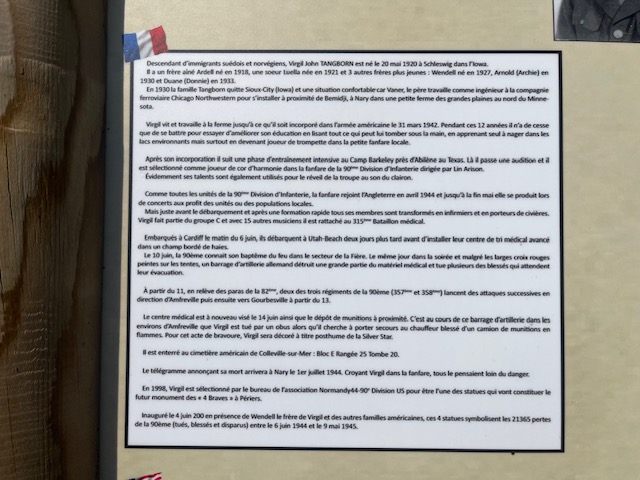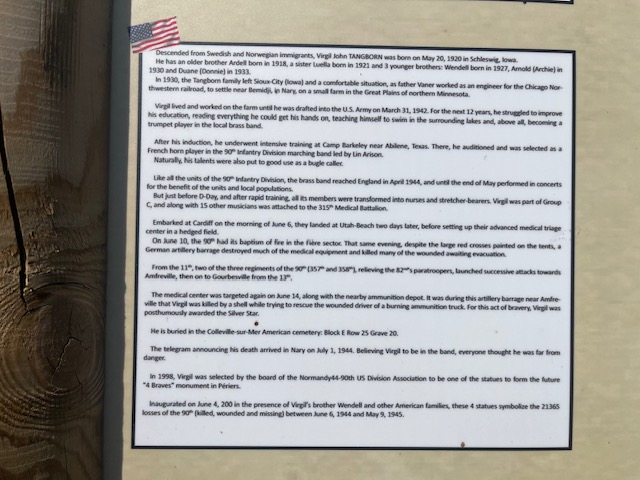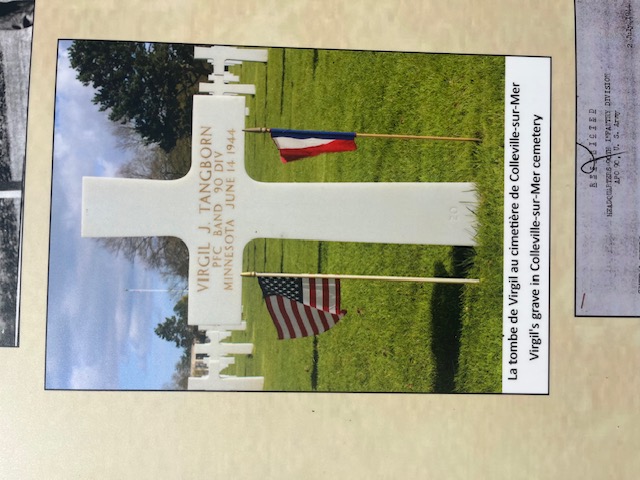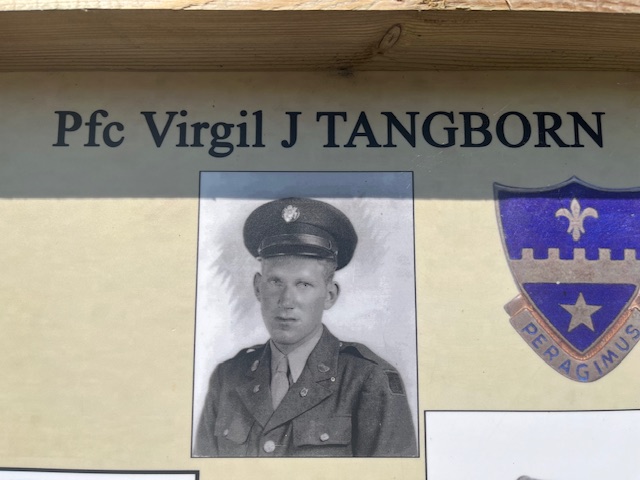Pfc Virgil J. Tangborn Information Board
Details:
On the right side of the monument.
Marker
A rectangular information board mounted on a wooden base honoring PFC Virgil J. Tangborn, highlighting his personal background and military service up to his death. The board, presented in both English and French, features his photograph, the citation for the award he received posthumously, an image of his gravestone and the ‘’4 Braves’’ statues, and the insignias of the units he served with during World War II.
Source of photos: Kelly Carrigg
Monument Text:
English text:
Descended from Swedish and Norwegian immigrants, Virgil John TANGBORN was born on May 20, 1920 in Schleswig, Iowa. He has an older brother Ardell born in 1918, a sister Luella born in 1921 and 3 younger brothers: Wendell born in 1927, Arnold (Archie) in 1930 and Duane (Donnie) in 1933.
In 1930, the Tangborn family left Sioux-City (Iowa) and a comfortable situation, as father Vaner worked as an engineer for the Chicago Northwestern railroad, to settle near Bemidji, in Nary, on a small farm in the Great Plains of northern Minnesota.
Virgil lived and worked on the farm until he was drafted into the U.S. Army on March 31, 1942. For the next 12 years, he struggled to improve his education, reading everything he could get his hands on, teaching himself to swim in the surrounding lakes and, above all, becoming a trumpet player in the local brass band.
After his induction, he underwent intensive training at Camp Barkeley near Abilene, Texas. There, he auditioned and was selected as a French horn player in the 90th Infantry Division marching band led by Lin Arison. Naturally, his talents were also put to good use as a bugle caller.
Like all the units of the 90th Infantry Division, the brass band reached England in April 1944, and until the end of May performed in concerts for the benefit of the units and local populations.
But just before D-Day, and after rapid training, all its members were transformed into nurses and stretcher-bearers. Virgil was part of Group C, and along with 15 other musicians was attached to the 315th Medical Battalion.
Embarked at Cardiff on the morning of June 6, they landed at Utah-Beach two days later, before setting up their advanced medical triage center in a hedged field.
On June 10, the 90th had its baptism of fire in the Fière sector. That same evening, despite the large red crosses painted on the tents, a German artillery barrage destroyed much of the medical equipment and killed many of the wounded awaiting evacuation.
From the 11th, two of the three regiments of the 90th (357th and 358th), relieving the 82nd’s paratroopers, launched successive attacks towards Amfreville, then on to Gourbesville from the 13th.
The medical center was targeted again on June 14, along with the nearby ammunition depot. It was during this artillery barrage near Amfreville that Virgil was killed by a shell while trying to rescue the wounded driver of a burning ammunition truck. For this act of bravery, Virgil was posthumously awarded the Silver Star.
He is buried in the Colleville-sur-Mer American cemetery: Block E Row 25 Grave 20.
The telegram announcing his death arrived in Nary on July 1, 1944. Believing Virgil to be in the band, everyone thought he was far from danger.
In 1998, Virgil was selected by the board of the Normandy44-90th US Division Association to be one of the statues to form the future “4 Braves” monument in Périers.
Inaugurated on June 4, 200 in the presence of Virgil’s brother Wendell and other American families, these 4 statues symbolize the 21365 losses of the 90th (killed, wounded and missing) between June 6, 1944 and May 9, 1945.







